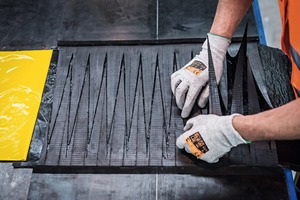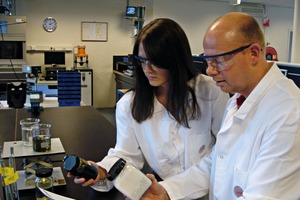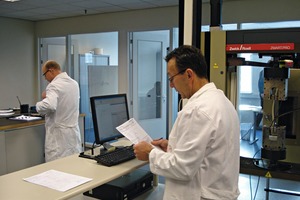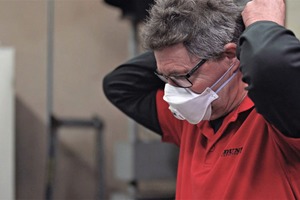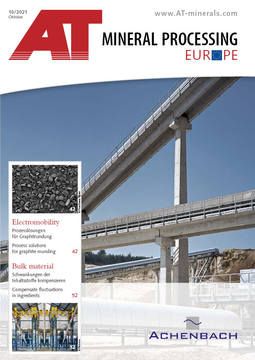Are your conveyor belts safe to handle?
Since its inception, the various component parts of REACH regulations have continued to develop in line with ongoing scientific research. Not only have the goalposts moved, the playing field itself seems to be moving. Here, one of the industry’s leading conveyor belt application engineer’s, Rob van Oijen, reports on the latest state of the regulations and issues a stark warning to those who continue to turn a blind eye to the very genuine safety aspects involved.
When REACH (Registration, Evaluation and Authorisation of Chemical substances) regulation EC 1907/2006, first came into force in June 2007, it is fair to say that it largely went unnoticed by the conveyor belt industry. After all, the possibly hazardous chemicals used to make thick, heavy rubber industrial conveyor belts could surely not pose a risk compared, say, to rubber products handled and used by the general public. Thanks largely to the benefit of 14-years of hindsight, most of the manufacturers are now far more aware of the seriousness of such issues and the much greater duty of care is owed not only to our families and ourselves but also to the work colleagues.
Why worry?
The reason why the levels of hazardous chemicals that conveyor belts contain are such a cause for concern is twofold. Firstly, there are the proven harmful effects that ’substances of very high concern’ (SVHC’s) can have on humans and the environment. Secondly, and equally important, there is an ever-growing list of substances still under research that are suspected by scientists to have potential harmful effects. Sadly, history is littered with examples of substances (asbestos example) that were thought to be safe at the time but ultimately proved to have seriously damaging effects.
As far as conveyor belts are concerned, those who regularly work with them as part of their job role, such as conveyor maintenance staff and belt splicers for example, are potentially at greatest risk and therefore most in need of safeguards. Fortunately, at least as far as Europe is concerned, very strong regulations are in place to protect humans and the environment in the form of REACH.
Accountability and responsibility
Perhaps not surprisingly, some European conveyor belt manufacturers have chosen to ignore this legal requirement, either completely or at least partially because of the impact on production costs. Manufacturers located outside of EU member states and the UK are not, of course, subject to the regulations. Neither are they subject to EU regulation concerning Persistent Organic Pollutants (POPs). This means that they are free to use unregulated raw materials even though those same materials may be entirely prohibited or at least have strict usage limitations within the European community. Although manufacturers located outside of EU member states are not subject to the regulations, those who import conveyor belts from outside of Europe are responsible for the application of REACH regulation, leaving the actual manufacturers free of responsibility and the consequences.
REACH, and other chemicals regulations, were retained in UK domestic legislation at the end of the Brexit transition period via the European Union (Withdrawal) Act 2018. Secondary legislation was also passed that amended REACH to make it work in a UK-only context from that point onwards. The UK Government put in place a separate UK REACH regime that applies to businesses that import, make, sell or distribute chemicals in Great Britain, whether as raw materials or in their finished state.
The UK REACH Regime was designed to establish a UK-wide market for chemicals applying to all chemical substances manufactured and imported into the UK, with the Health and Safety Executive (HSE) established as the UK REACH Competent Agency, taking over the functions of the ECHA. Under the Northern Ireland Protocol, however, the EU REACH Regulation will continue to apply to Northern Ireland after the end of the transition period, while UK REACH will regulate the access of substances to the market in Great Britain, as set out in the EU Exit Regulations of 2020. The UK REACH regime is designed to replicate the EU system as closely as possible, maintaining the fundamental aims and purposes of REACH including high standards of health and environmental protection.
The use of chemicals in conveyor belt manufacturing
The vast majority of the rubber used to make modern-day conveyor belts is actually synthetic or, at most, contains only a relatively small element of natural rubber. In basic scientific terms, the creation of rubber compounds is the process where a range of ’specific task’ chemicals, reinforcements and anti-degradants are mixed together with rubber polymers. The most common polymers used in conveyor belts are Styrene-Butadiene rubber (SBR) and Nitrile rubber (NBR). The chemical agents form chains of polymers to form rubber compounds that will ultimately be vulcanised to create the finished product.
There are literally hundreds of different components that are used to create the various rubber compounds, such as anti-degradants, anti-ozonants and also as accelerators, essential for the vulcanisation process for example. These components include primary amine-based sulfenamides, such as N-cyclohexyl-2-benzothiazole sulfenamide, and thiazoles, such as 2-mercaptobenzothiazole. It is an inescapable fact that to make some rubber compounds it is necessary to use chemicals that are extremely dangerous in their own right. What REACH does is to strictly limit the amounts of certain chemicals that are used in each product, encourage safer substitutions and, in some extreme cases, ban them altogether.
One of the biggest concerns involves short-chain chlorinated paraffin’s (SCCP’s). These are commonly used to accelerate the vulcanizing process. REACH regulations clearly stipulate that SCCP’s should either not be used at all or at least only used on a very restricted basis because of their category 2 carcinogenic classifications. Their presence can usually be identified by the unpleasant smell of the rubber whereas good quality rubber usually has very little smell at all. Dunlop Conveyor Belting was one of the first conveyor belt manufacturers where compliance and requirements have been fully met.
Particularly since 2018, REACH regulation regarding SVHC (substances of very high concern) has become increasingly stringent and demanding. Previous REACH compliance was largely based on declaring (registering) the use of listed chemical substances and staying within specific limits applicable to each substance. Now, Article 31 of REACH (requirements for safety datasheets) demands that if a product contains SVHC that is more than 0.1 % of the total weight of the finished product then the manufacturer is compelled to both register its use with the European Chemicals Agency and provide their customer with a safety datasheet.
Accurately calculating the total proportion of weight relating to SVHC for an individual product is quite a painstaking task. But it is undoubtedly absolutely necessary. At Dunlop, the weight of SVHC in all materials used in each product was recently reviewed and calculated. This also included materials supplied from outside, such as resin for example. The combined weight of SVHC was then calculated as a proportion of the gross weight of the product.
Not only do the proportions differ depending on the composition of each product type, they also differ depending on the thickness of the rubber covers. The proportion in terms of weight is naturally higher in thinner, lighter products. Responsible companies simply have to accept this as a fact. Dunlop manufactures its own rubber and also every belt itself, so the company has total control. What worries me is that the majority of belt used in Europe nowadays is imported from outside of Europe, mostly from Asia, so it is virtually impossible to know how much SVHC and Persistent Organic Pollutants (POPs) these belts contain.
Working safe
Although Brussels is often accused of over-zealous regulation the use of potentially harmful chemicals and materials should not be compared with regulations concerning the straightness of bananas or the size of eggs. It is nevertheless important that users of rubber conveyor belts make themselves aware of potential hazards. It is important to always ask for written confirmation from the belt manufacturer or supplier that the purchased product has been produced in compliance with REACH EC 1907/2006 regulations.
At the same time, basic safety precautions for those working with conveyor belts should be applied. Firstly, gloves should be worn when handling conveyor belts if possible. Secondly, it is advisable to wash your hands before drinking, eating or smoking. Lastly, those involved in actions that may cause rubber dust to be produced, such as grinding for example, should wear a mask to prevent inhalation of dust particles.
Author:
Rob van Oijen, Manager Application Engineering, Dunlop Conveyor Belting, Drachten/NL
Rob van Oijen is Manager Application Engineering for Dunlop Conveyor Belting in The Netherlands. He has specialised in conveyors for some 14 years, supporting businesses throughout Europe, Africa, the Middle East and South America.




